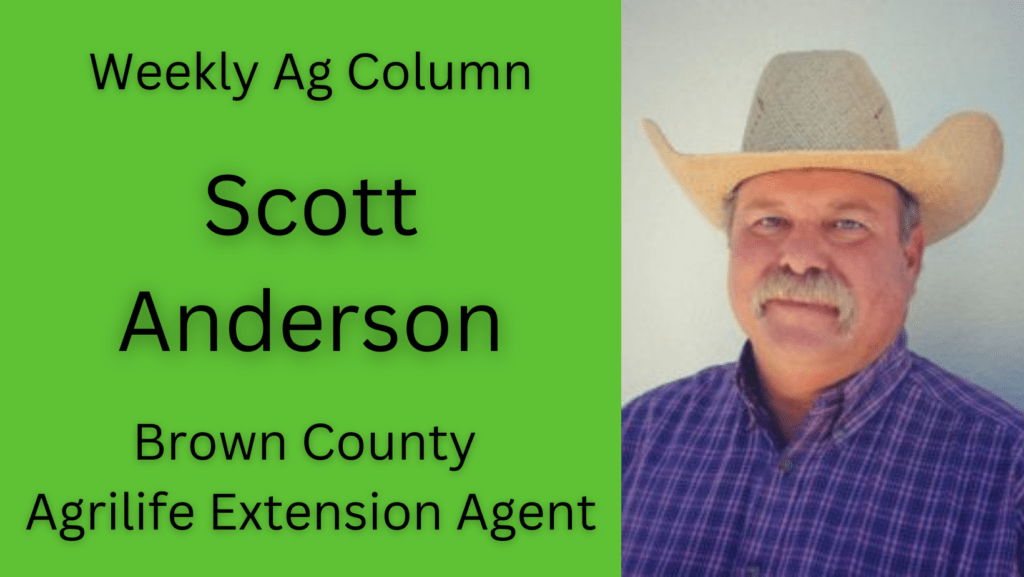
Forage Seminar will be held on January 23, 2024, in Cross Plains. This annual event has become one of the premier educational programs concerning forage production and hay in our region. The seminar will take place at the First Baptist Church in Cross Plains. Registration will begin at 8:30 a.m., and the program will start at 9:00 a.m. 5 CEUs are pending by the Texas Department of Agriculture will be offered at the Forage Seminar. Topics will include:
- Reading Labels and Herbicide Updates
- Integrated Pest Management on Forages
- Importance of Healthy Soil
- Selection of Sudan Grasses for aphid control and selection for forage production
- Brush and Weed Management in Pastures
- Laws and Regs
Pre-register by calling the AgriLife Extension office in Callahan County at 325-854-5835, Brown County 325-646-0386, and Coleman County 325-625-4519. Fees are due upon arrival and include a catered noon meal. Cost for the program is $40 if preregistered by January 18, 2024, $50 after 18th.
Two measures key to cow-calf profits
As we open the final month of the year, most spring-calving, cow-calf operations have weaned calves and have an opportunity to assess the productivity and profitability of their herds. I wanted to quickly review two measures that I feel are of utmost importance to a cow-calf operator.
Neither measure carries a dollar sign, but both have serious implications for the revenue side of the profit equation. There is no shortage of measures and indices that can be helpful for cow-calf operators, but the weaning rate and pounds of weaned calf per cow are two that I think are very important, but also relatively simple to understand and calculate.
Weaning rate is the percentage of cows exposed to a bull that wean a calf in a given year. If a farmer exposed 50 cows and weaned 45 calves, the weaning rate for that operation would be 90% (45 calves divided by 50 cows). There is a cost to maintaining and breeding cows whether they wean a calf or not, so limiting the number of cows that incur costs and fail to wean a calf is crucial.
Holding all other things constant, herds with higher weaning rates will be more profitable than those with lower weaning rates. If weaning rate is an issue, farmers should work to determine if the issue is cows failing to breed, cows losing calves, or calf survival.
An easy way to think about the weaning rate is that it converts revenue per calf to revenue per cow. Table 1 below provides a simple way to illustrate this concept. If one assumes that an average calf is weaned at 550 lbs and is worth $2.30 per lb (for simplicity think steer-heifer average), then the value of each calf is $1,265 at weaning.
However, when this is discounted for cows that were maintained but did not wean a calf, the revenue picture on a per cow basis is very different. Each 5% change in weaning rate impacts revenue per cow by more than $60. That difference expands in stronger calf markets and contracts in weaker calf markets, but the fact that weaning rate significantly impacts profit is undeniable.
The second measure is pounds of weaned calf per cow. This measure builds upon weaning rate by also including weaning weights. Pounds of weaned calf per cow can be calculated by dividing the total number of weaned pounds by the number of cows exposed to a bull or by multiplying the average weaning weight for the operation by the weaning rate. I like to think of pounds of weaned calf per cow much like a yield measure for a crop operation – production per unit. Weaned pounds are the production level and cows are the unit. This measures the pounds of weaned calf a cow-calf producer can potentially sell for every cow he or she maintains.
The wide range across the table speaks to how much this measure can vary across operations. This is not to say that a higher level of pounds of weaned calf per cow is always desirable because this measure does not incorporate any additional costs associated with higher weaning weights or other considerations of the operation. Tracking and managing that number will have profit implications for the operation over time.